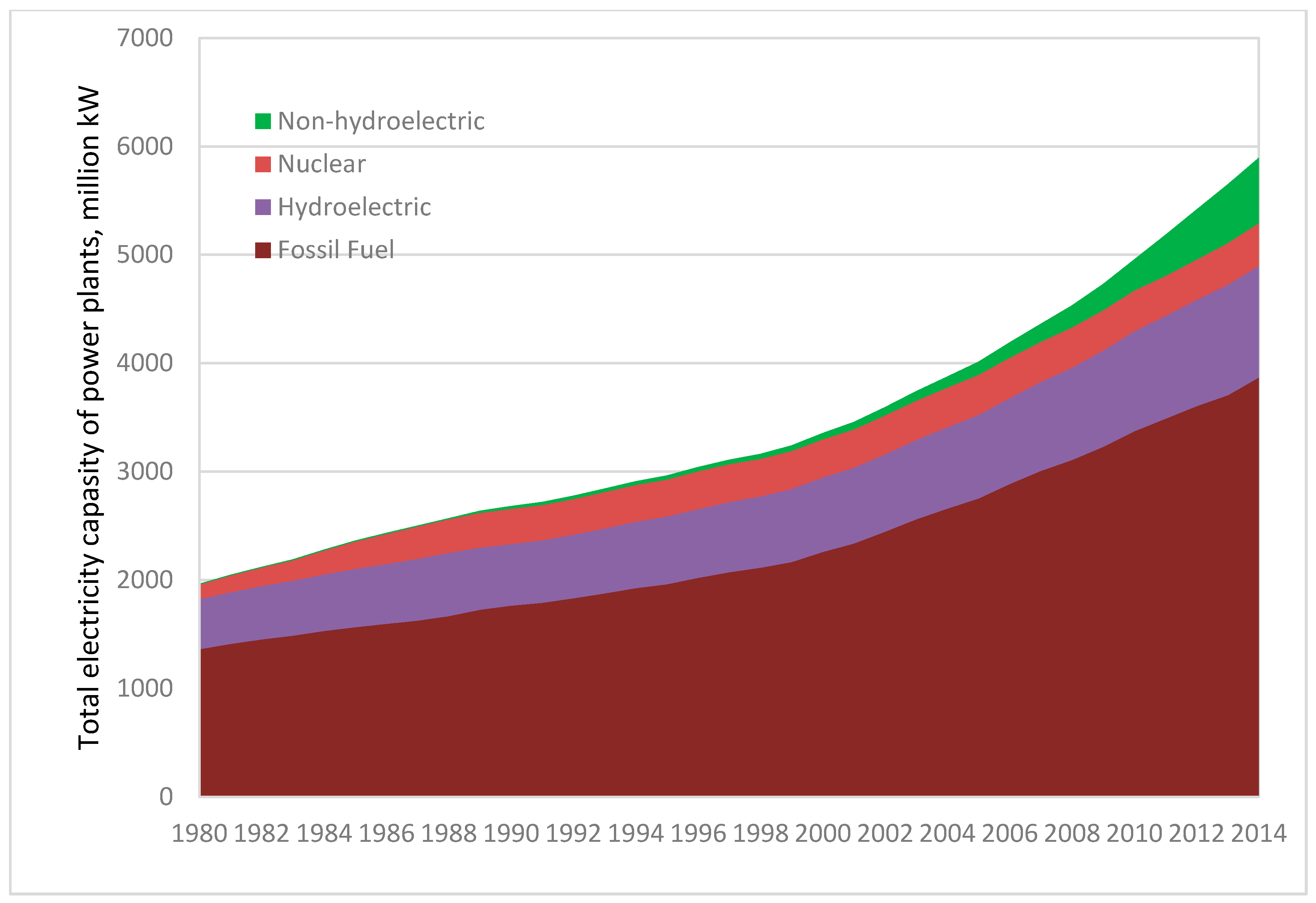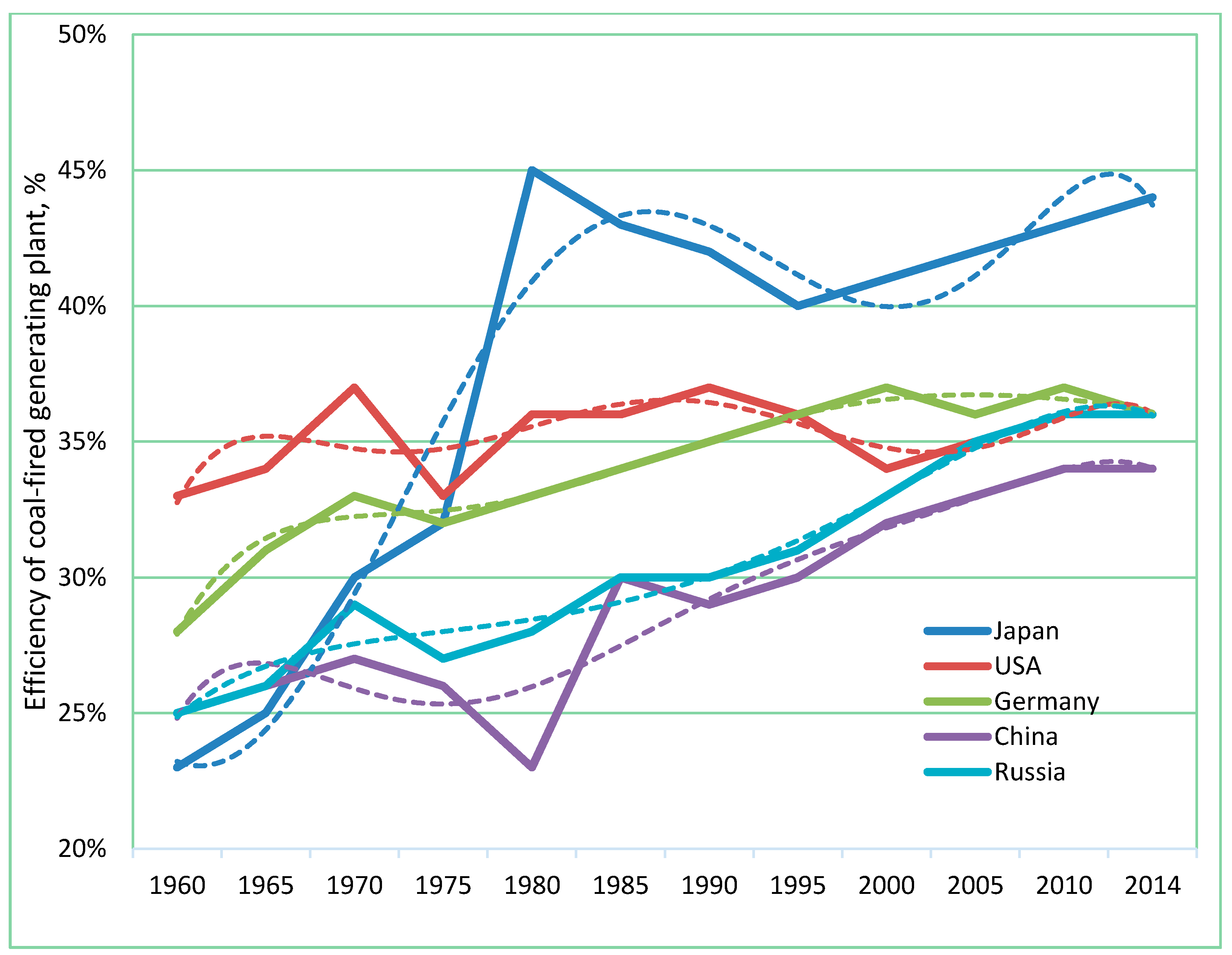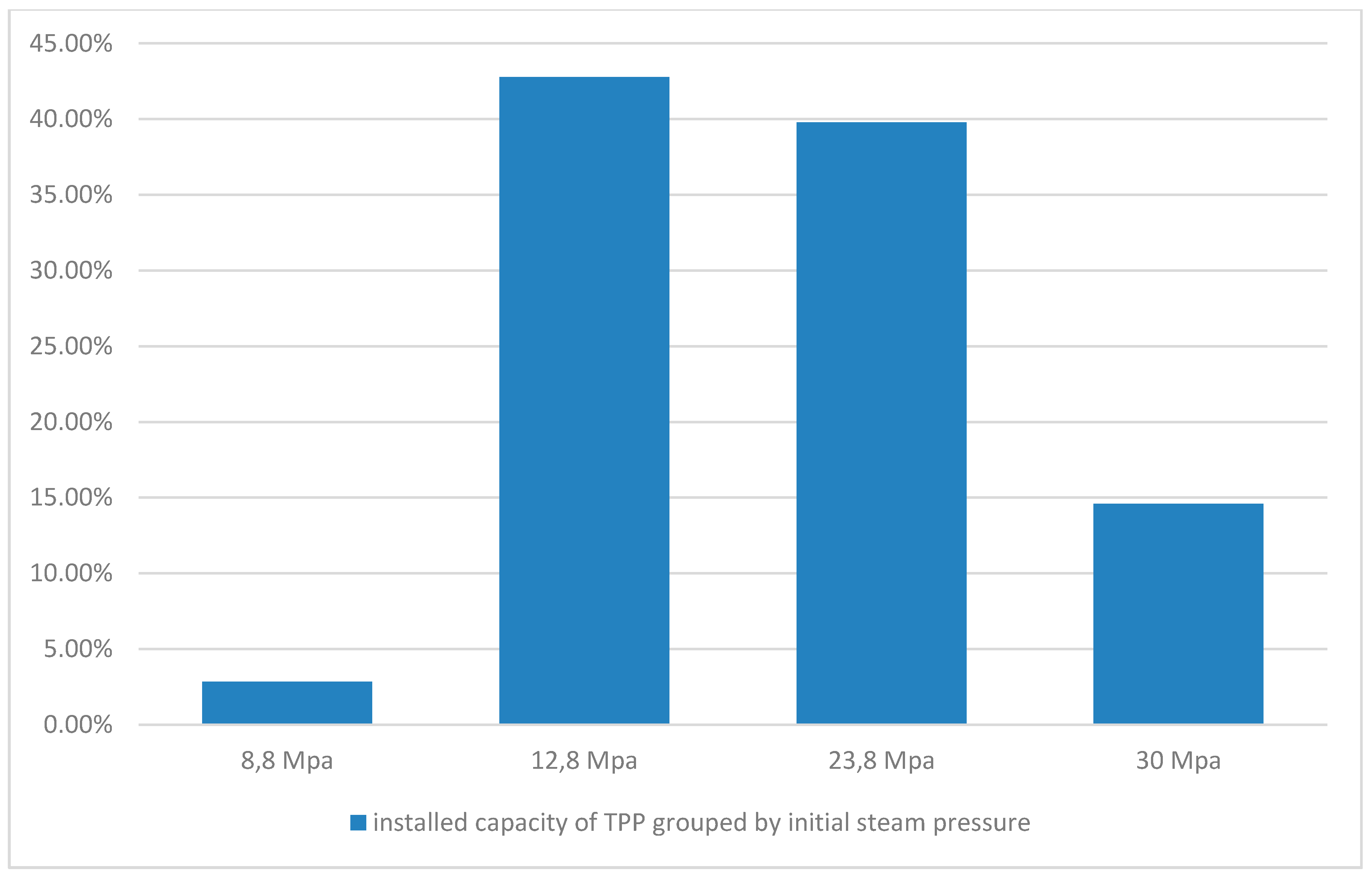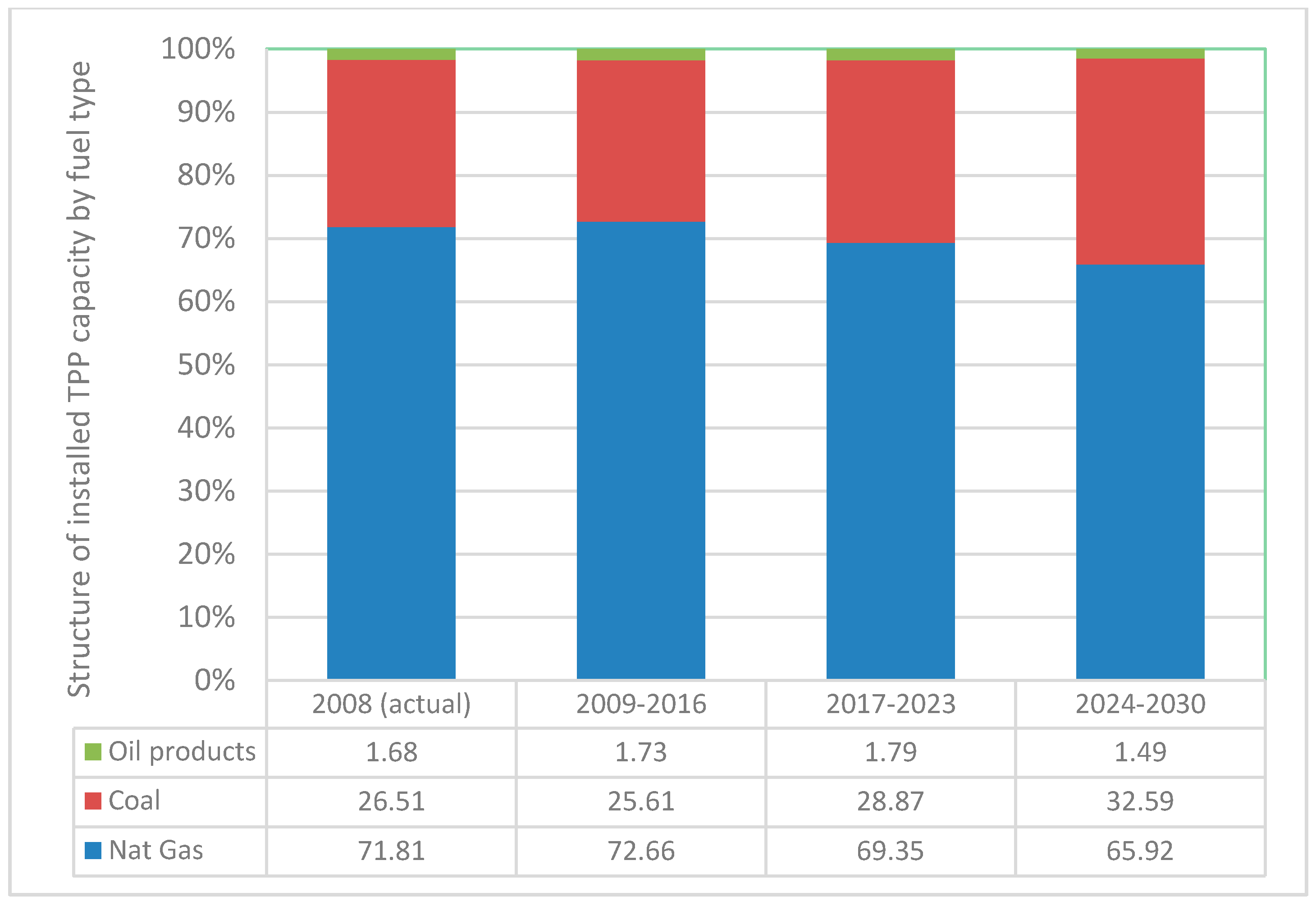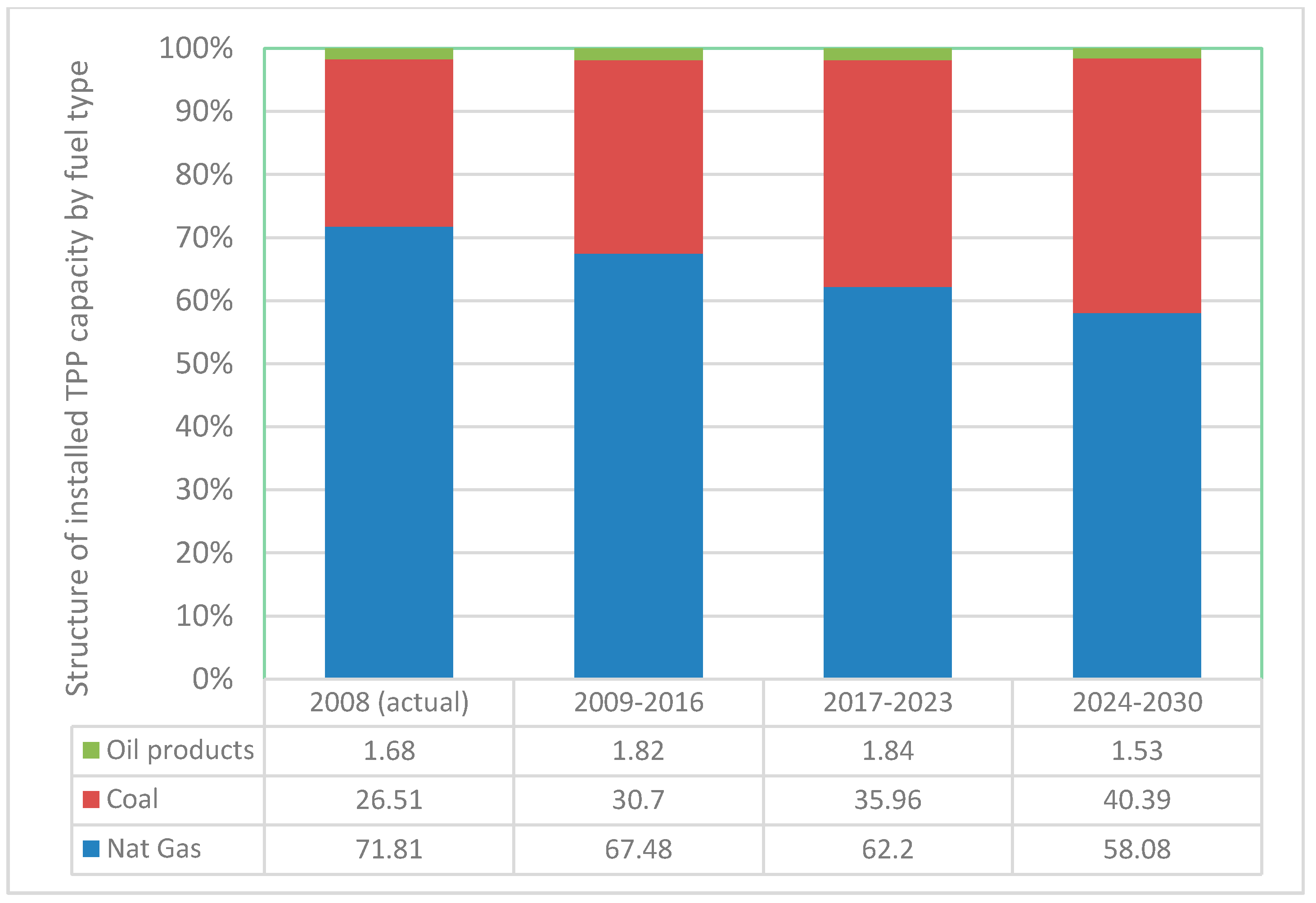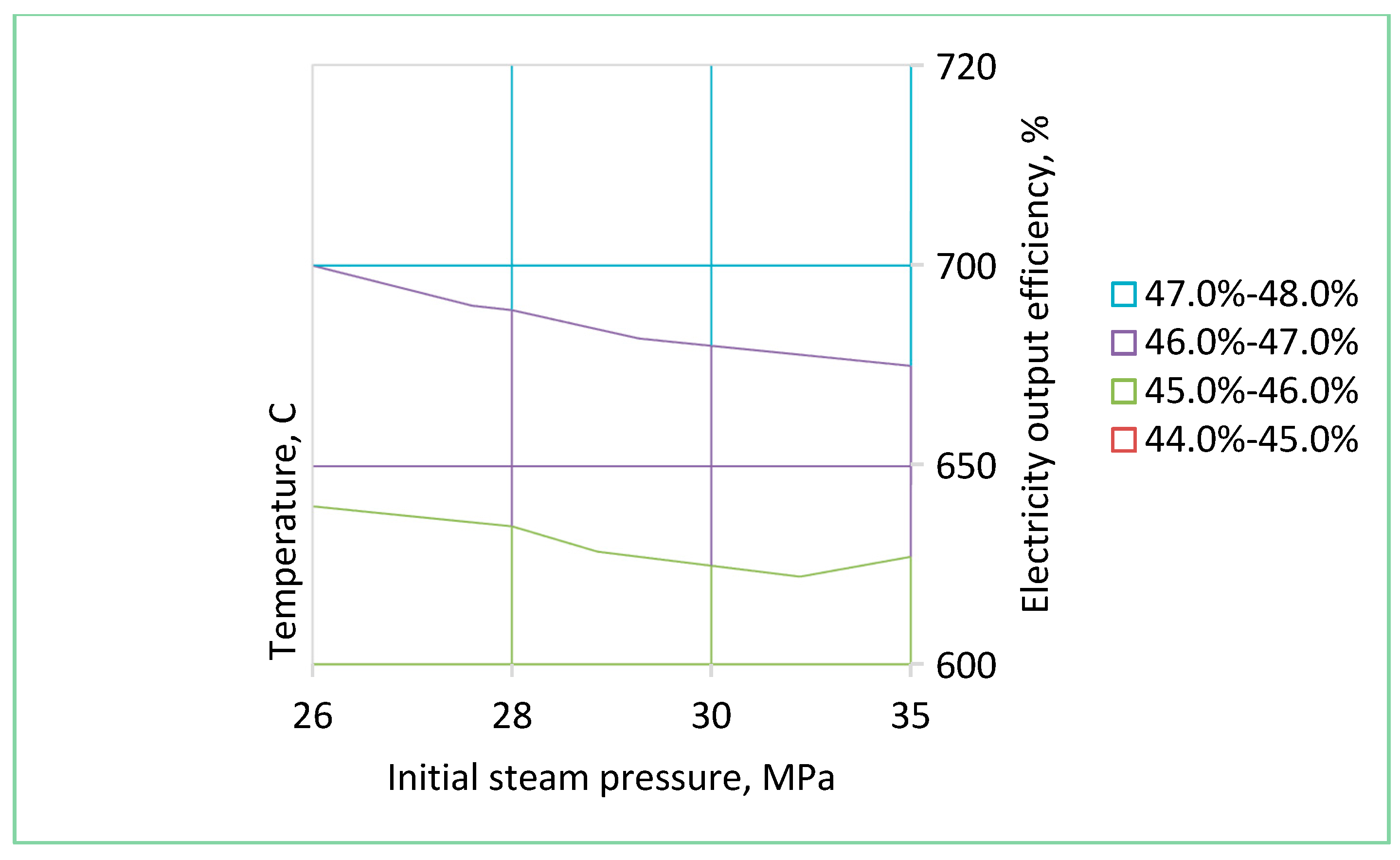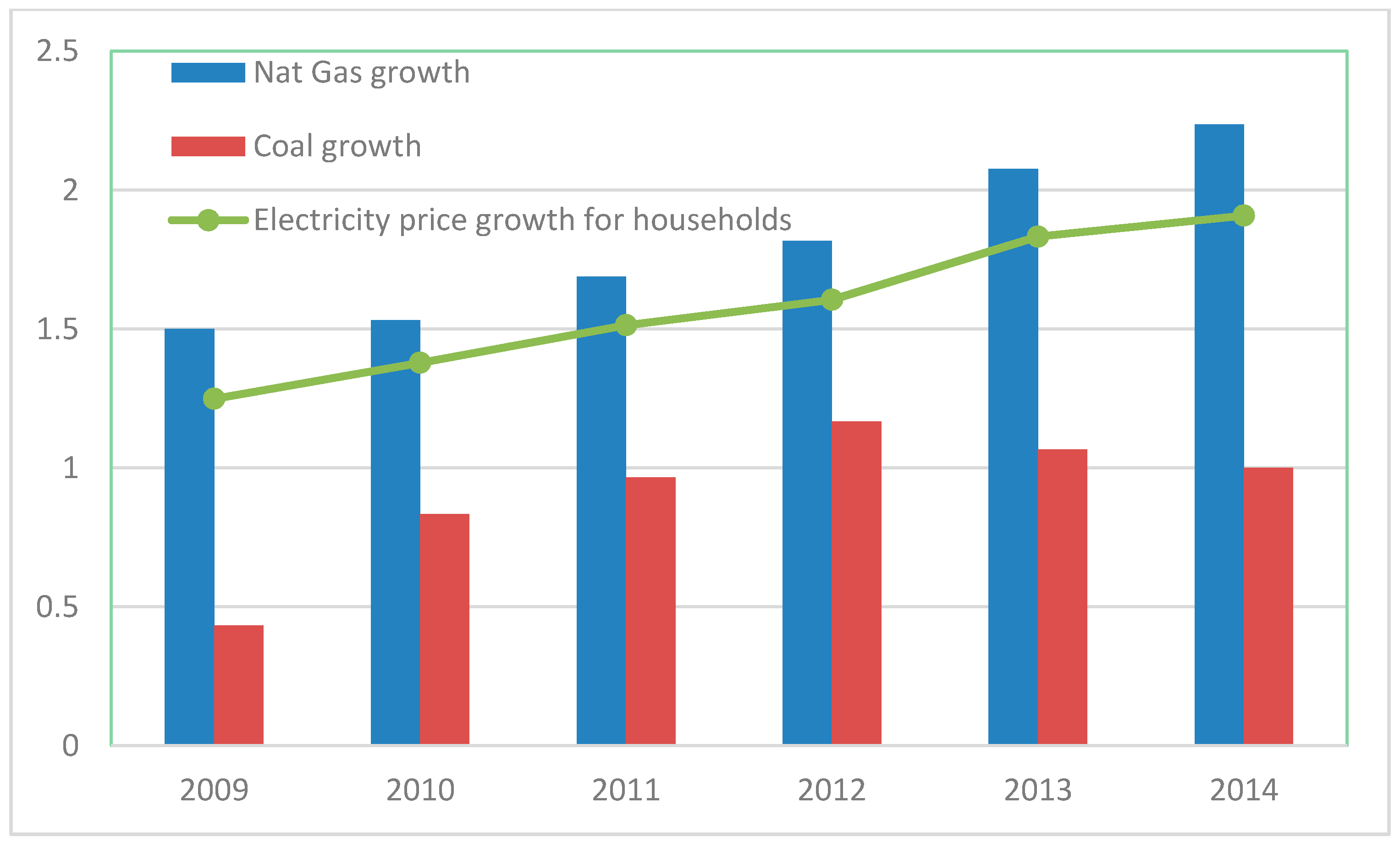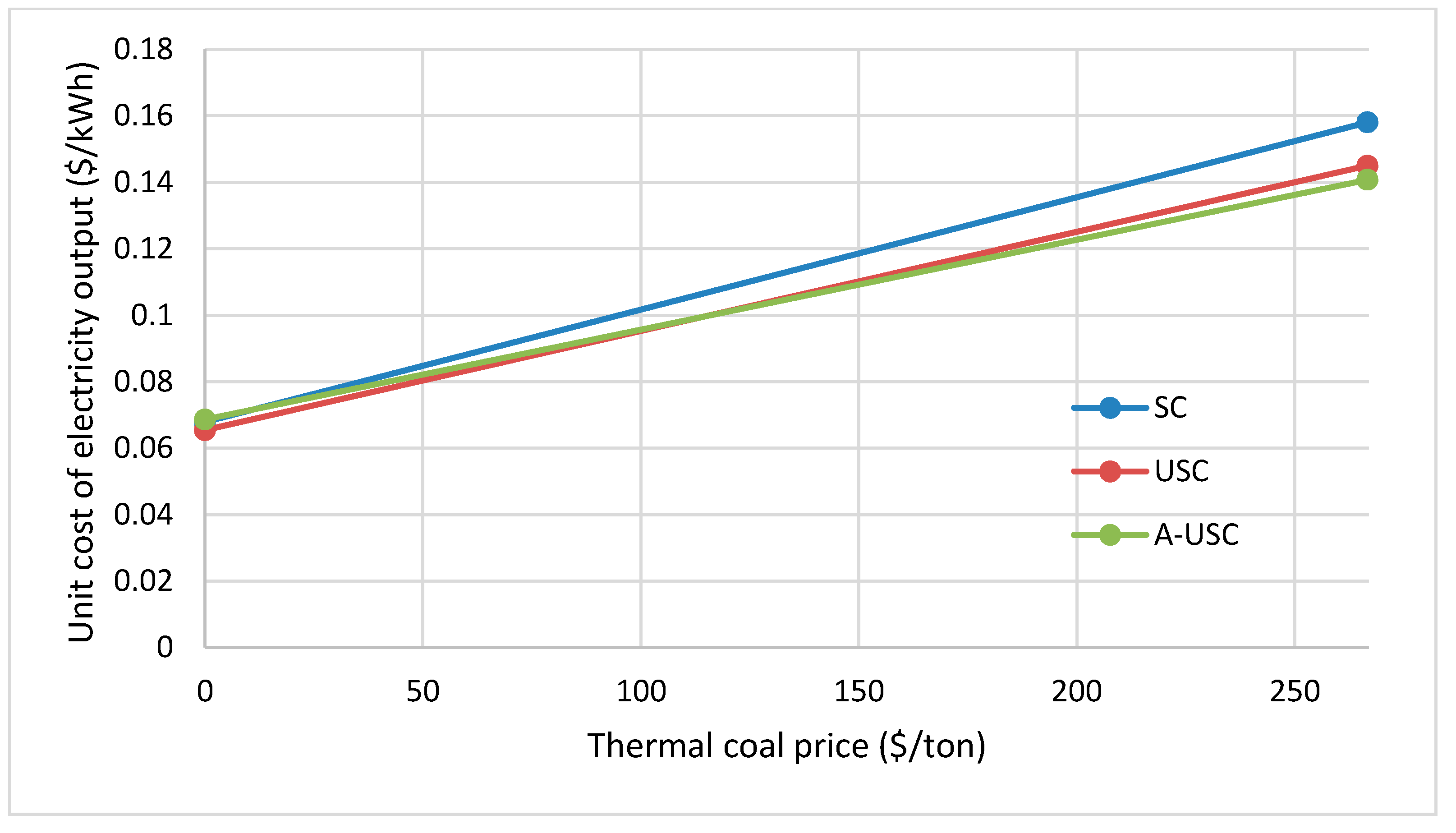1. Introduction
No long-term development of the national economy is possible without parsimonious use of natural resources and a respectful attitude toward the environment. Everyday management of various industries of the national economy, particularly the power utilities industry, must not only be aligned with the demands of contemporary society, but should also seek to secure fair living conditions for future generations.
According to
Limits to Growth, a study published by the Club of Rome in 1972, population growth coupled with production growth and the resulting environmental strain will ultimately lead to one of two outcomes. The authors [
1] believe that exponential population growth will eventually result either in a complete crash of the existing consumer-driven economy, or a severe crisis with consequences that can be mitigated by adjusting the social production structure to reach an agreement between social, environmental, and economic indicators of national welfare.
Population growth brings about increased needs that can only be satisfied if there is a steady production process, which in turn depends on the sufficiency and availability of resources extracted from the environment. Moreover, the production process is always associated with generation of waste that pollutes the environment. Experts in global environment issues and energy policy cite different projections of the limit to population growth and air/water pollution rate; however, all of them agree that such a limit does exist and has been approached quite closely by mankind.
Avoiding collapse at the national level requires adjusting national economies to prioritize qualitative development—balancing consumption with the environment’s capability for recovery of resources expended on the production of economic assets.
National economy is shaped by multiple industries, each under control of a specialized government department. A successful nationwide sustainable development strategy implies a number of industry-specific development strategies taking the interests of future generations into account.
Figure 1.
Development of installed electric power plant capacity worldwide across different types of primary energy sources. Source: U.S. Energy Information Administration: International Energy Statistics [
2], own research.
Figure 1.
Development of installed electric power plant capacity worldwide across different types of primary energy sources. Source: U.S. Energy Information Administration: International Energy Statistics [
2], own research.
Power utilities are a key industry of the national economy from the standpoint of ensuring economic stability. National security hinges on the efficiency and reliability of the grid. The utilities sector necessarily leads the development of other sectors of the economy to accommodate the ever-growing demand for electricity. Our analysis of global data concerning the construction of all types of generating assets supports the conclusion that electricity use has grown dramatically over the past 30 years.
Figure 1 shows the global change in installed capacity of electric power plants, broken down by fuel types.
Despite alternative and renewable energy making significant gains in installed capacity over the past decade, consumption of classical energy resources (oil, gas, and coal) is on the rise, with traditional thermal power plant technology based on chemical transformation of organic fuel retaining its key role.
A thermal power plant (TPP) is the basic generating unit in the traditional thermal generation field. Intense use of organic fuels at TPPs to meet the demand for electric energy, coupled with the scarcity of this resource, is a major driver behind the development of efficient energy transformation technologies.
Figure 2 shows charts reflecting the gradual increase in efficiency of coal-fired generating plants in countries with the most developed power utilities. It can be seen that countries most affected by the shortage of organic fuels are making faster progress in the development of efficient generation technology.
Figure 2.
Efficiency trend for coal-fired generating plants in countries with the most developed power utilities. Source: International Energy Agency [
3], own research.
Figure 2.
Efficiency trend for coal-fired generating plants in countries with the most developed power utilities. Source: International Energy Agency [
3], own research.
According to a global forecast for power utilities development [
4], classical thermal power plants will retain their dominating role in supplying the electricity needs of national economies. A gradual transition from natural gas to coal as the primary fuel will take place at the same time.
Russia is no exception to this global trend. As of 2014, 66% of Russia’s installed capacity was thermal [
5,
6]. The Energy Strategy of Russia for the Period up to 2030 (hereinafter referred to as Strategy) sets long-term targets for the development of the power utilities sector. According to the Strategy, the share of traditional generation in installed capacity will range between 56% and 67.6% by 2030, depending on the overall development scenario of the industry [
7]. Electricity consumption growth combined with the significant wear/obsolescence of existing generating assets (
Figure 3) prompts construction of numerous new stations.
Figure 3.
Forecast of new capacity startup rates in Russia for various scenarios of electricity demand growth and asset obsolescence. Source: Energy Strategy of Russia for the Period up to 2030 [
7], own research.
Figure 3.
Forecast of new capacity startup rates in Russia for various scenarios of electricity demand growth and asset obsolescence. Source: Energy Strategy of Russia for the Period up to 2030 [
7], own research.
Due to the existing structure of the Russian power utilities industry, TPPs do not enter the market independently, usually operating as parts of wholesale generating companies (OGKs) or territorial generating companies (TGKs/TGCs) [
8,
9]. Utility companies plan the development of generating plant capacity by coordinating key parameters of their future projects for new capacity with the Ministry of Energy of Russia, an authority tasked with state regulation and development management of the national grid and the power utilities industry in general. Based on utility companies’ plans for new capacity deployment and in view of state interests, a General Location Plan of Power Utilities Assets (hereinafter referred to as the Layout Plan) is drafted, subject to approval by the Government of the Russian Federation [
10].
The Location Plan is issued as a list of power utilities assets planned for startup in Russian Federation in the specified period of time. For thermal power plants, this given document includes the following information [
10]:
- (1)
Location of planned TPP
- (2)
Fuel type
- (3)
Generating unit type
- (4)
Installed capacity
- (5)
Number of generating units.
These parameters of the generating asset will be approved provided that they meet following conditions:
- (1)
The total installed capacity in the grid always exceeds the economy’s demand for electricity by a contingency factor accommodating maintenance downtimes of generating equipment and covering peak loads.
- (2)
It is technically possible to hook up the newly-built power plant in the chosen location to the high-voltage transmission system. The throughput of transmission lines or individual system components must not limit transmitted power in this case.
- (3)
It is technically possible to supply the TPP with the chosen type of fuel in amounts necessary to ensure operation under any process conditions.
- (4)
The future TPP must be able to respond to a power drop or increase commands issued by the system operator (SO) in order to maintain the electricity supply/demand balance and to maintain the specified parameters of the grid, particularly the alternating current frequency of 50 Hz.
The matter of choosing a generation technology remains the responsibility of the generator company whose primary concerns are ensuring commercial efficiency of the project and designing the power plant to meet minimum environmental standards, which are quite lax in Russia at present compared to foreign counterparts. In particular, it is legal for TPPs with subcritical steam (up to 8.8 MPa/535 °C) to be constructed without any environmental protection provisions. The existing Power Plant Construction Plan up to 2020 is dominated by assets of such kind [
10,
11].
Figure 4 shows the power structure of the TPP that is planned to be commissioned in 2020, grouped by the initial steam parameters.
Figure 4.
Power structure of the TPP that is planned to be commissioned in 2020, grouped by the initial steam parameters. Source: Ministry of Energy of Russia [
10], own research.
Figure 4.
Power structure of the TPP that is planned to be commissioned in 2020, grouped by the initial steam parameters. Source: Ministry of Energy of Russia [
10], own research.
The choice of thermal generation technology determines a range (depending on the process mode) of possible specific fuel consumption rates [grams of fuel equivalent per kWh] having immediate bearing on the consumer price of generated electricity as well as the specific generation rate of combustion products such as carbon dioxide (CO2) and sulfur oxides (SOx). Despite the choice of the generation technology having a major impact on social and environmental aspects of the nation’s sustainable development, the Location Plan as the primary strategic planning tool of the power utilities industry disregards this crucial factor, threatening a national economic crisis in the long term. The power-generating complex is in need of new governance models with the capability of evaluating the impact of massively deployed electricity production technologies on social, environmental, and economic components of national development so as to promote more efficient and cost-saving TPPs.
Russia’s energy strategy up to 2030 provides for a gradual reduction of the share of natural gas burnt by power plants and an increase of the share of coal [
7,
11]. Coal-fired technology is of special interest for researchers due to the special role that coal-fired TPPs will play in Russia’s national grid when key provisions of the Strategy are put in practice. The primary goal of this paper is evaluating the effect of coal-fired generation technology level on economic, social, and environmental aspects of national development and translating the resulting estimates into recommendations for optimum choice of key fundamental technologies to ensure the sustainability of assets in the Location Plan.
2. Assessing the Conformity of Russia’s Energy Strategy with the Sustainable Development Concept
National energy security is the core priority of Russia’s energy strategy. The Strategy defines energy security as a condition when the country, the society, the state, and the economy are all secure from threats to reliable supply of fuel and electricity [
11]. Such threats may be owed both to external factors (geopolitical, macroeconomic, and circumstantial) and the state and functioning of the country’s energy and utilities sector.
Energy security is a product of three components [
7,
11]:
- (1)
Resource sufficiency: the physical capability to supply the national economy and the population with energy resources while avoiding shortages;
- (2)
Economic availability: the cost efficiency of energy supply at the current price level;
- (3)
Environmental and technological acceptability: the ability to extract, produce, and consume energy resources within the limits of existing technologies and environmental constraints determining operational safety of utility assets.
The sustainable development concept [
12] specifies three stability conditions for an economic system:
- (1)
Renewable resources should not be depleted faster than their recovery rate;
- (2)
The rate of depletion of nonrenewable resources must not exceed the pace at which substitutes based on other renewable resources are developed to replace the nonrenewable resource;
- (3)
The pollution rate should not be faster than the rate at which the environment is able to assimilate such pollution.
This allows for increased rates of resource consumption provided that—in order for the economic system to remain stable—there is a commensurate increase in the rate of resource recovery or the pace of substitute development. The logical corollary to these sustainable development considerations is that the national economy growth rate will be capped by the rate of recovery of consumed resources, with either nature or state-of-the art technology determining the latter. Development and introduction of efficient technologies will ensure reduction in the consumption of nonrenewable resources together with faster recovery of renewable resources, thus increasing the consumption of goods without compromising the stability of the economic system.
The emphasis on resource sufficiency, economic availability, and environmental and technological acceptability in Russia’s energy strategy places the power utilities industry into a development framework that fails to promote transition to sustainable development due to the following reasons:
Resource sufficiency means that the development of the utilities industry should be aimed at attaining a dynamic condition whereby the national economy is supplied with the required amount of resources at any moment. That is, as long as the national economy maintains its course of predominantly extensive growth, the energy and power utilities industry is expected by the Energy Strategy to ramp up its output proactively, thus inevitably speeding up the depletion of natural resources and straining the environment even further. Despite all that, little attention is paid to renewable generation.
Profitability is chosen as the economic criterion of industry’s development. However, profit margins earned by a generating asset are not always determined by the technology level with its direct relationship with fuel consumption. In a market routinely experiencing high electricity prices coupled with cheap fuel, there are no drivers for the introduction of more advanced electricity generation technologies as the generating company is content with its current technology.
The environmental aspect of power utilities’ development is specified in terms of exposure limits for various types of emitted pollutants. Maximum permitted concentrations of harmful pollutants are specified for regions of the country at every stage of implementation of the Strategy. Exceeding specified thresholds makes the generating company liable for a fine. On the other hand, environmental protection law makes no distinction between a company that is consistently implementing harmful emission reduction technologies and a company that finds itself able to comply with environmental law without taking any additional environmental action. As a result, today’s Russia lacks economic incentives to reduce pollutant emissions below the threshold set by the Federal Service for Supervision in the use of Natural Resources.
3. Prospects of Coal-Fired Power Plant Technology Development from the Standpoint of Russia’s Energy Strategy Priorities
The Strategy aims to ensure resource sufficiency by a gradual reduction of the share of natural gas and an increase of the share of coal in the structure of fuels burnt by power plant.
Figure 5 and
Figure 6 show the projected gradual changes in the organic fuel consumption structure for baseline and maximum scenarios of Energy Strategy implementation.
Figure 5.
Structure of installed TPP capacity by fuel type (baseline scenario). Source: Ministry of Energy of Russia [
7], own development.
Figure 5.
Structure of installed TPP capacity by fuel type (baseline scenario). Source: Ministry of Energy of Russia [
7], own development.
Figure 6.
Structure of installed TPP capacity by fuel type (maximum scenario). Source: Ministry of Energy of Russia [
7], own development.
Figure 6.
Structure of installed TPP capacity by fuel type (maximum scenario). Source: Ministry of Energy of Russia [
7], own development.
Data shown in
Figure 5 and
Figure 6 clearly demonstrate a high-priority goal for the modernization of Russia’s power utilities industry: decreasing its dependence on natural gas and diversifying its fuel balance. It should be noted, however, that this goal is already met if the baseline scenario is considered, meaning that there is a likelihood of inverse dynamics,
i.e., a gas-fired power plant gaining a share in the structure of installed capacity.
Figure 7 compares the actual structure of installed thermal capacity against scenario projections.
Figure 7.
Actual structure of installed TPP capacity compared to projected structure for baseline and maximum cases. Source: Ministry of Energy of Russia [
7], own development.
Figure 7.
Actual structure of installed TPP capacity compared to projected structure for baseline and maximum cases. Source: Ministry of Energy of Russia [
7], own development.
Another priority of the Strategy is consistently increasing the functional efficiency of power plants. Average efficiency of coal-fired power plants is planned to reach 41% by 2030, with the most advanced coal-fired stations having electricity production net efficiency between 45% and 47%. This objective can only be met by designing and implementing new coal-fired power plant technology.
Designers of power-generating machinery across the world now generally take the road of higher initial steam parameters: pressure P
0 and temperature t
0. From a thermodynamic standpoint, this is the only possible option for obtaining significant efficiency gains with turbine units, therefore increasing the efficiency of the power plant as a whole. Charts in
Figure 8 show the relationship between initial steam parameters and the electrical efficiency of a turbine unit.
Figure 8.
Effect of initial steam parameters on TPP net efficiency in terms of electric power output. Source: own research.
Figure 8.
Effect of initial steam parameters on TPP net efficiency in terms of electric power output. Source: own research.
An analysis of the relationship between TPP efficiency and initial steam parameters supports the conclusion that this efficiency is most prominently determined by initial steam temperature, t0. For example, if t0 is raised by 1%, TPP efficiency will gain 0.13% on average, while a similar increase in pressure P0 only results in a gain of 0.0086%. However, the potential for temperature increase is limited by the physical properties of state-of-the-art steels. For Russian steel brands the temperature limit is now 600 °C. In particular, 12Cr18Ni12Ti steel—a representative of the high-alloy austenitic class—can be used for power-generating equipment rated for operating steam temperatures up to 600–620 °С.
Generating units designed for initial steam parameters t
0 = 600–650 °С, P
0 = 26–31 MPa are regarded as ultra-supercritical (USC) worldwide. China, with 72.5% of its generating capacity represented by coal-fired plants, has the greatest number of generating units of this class [
13]. According to the International Entergy Agency, the total generating capacity of China’s USC plants totaled 54.5 GW in 2014.
Russia currently has no generating units operating with ultra-supercritical steam. However, according to the General Location Plan of Power Utilities Assets, 38 K-660-300 units (with individual installed capacity of 660 MW), three K-800-300 units (with individual installed capacity of 800 MW), and eight K-900-300 units (with individual installed capacity of 900 MW) are to be commissioned by 2020. USC steam is commonly defined in Russia as having initial pressure P0 = 30 MPa and initial temperature t0 = 600 °C. Russian designs of power-generating units rated for stronger steam USC unit foresee a 620 °C single-reheat unit. A generating unit with these ratings is expected to achieve an electricity output efficiency of 45.3%.
Increasing the initial steam temperature, in addition to improving the efficiency of the generating unit, also raises its cost. This cost increase is mainly associated with an increased share of high-alloy steel in the overall quantity of metal expended on the power plant machinery. According to Polish company RAFAKO, an increase in steam temperature from 540 °C to 600 °C translates into a 17% gain for the fraction of austenitic steels in the overall expenditure of metal for a power plant boiler [
14,
15]. Mao
et al. [
16] compares the prices of austenitic-class steels intended for high-temperature components of main power plant equipment with ferritic-martensitic steels widely used in power-generating equipment with a lower steam rating of 24 MPa/540 °C. According to 2014 data, P92 austenitic-class steel commands a five-fold premium in the market over P91 ferritic-martensitic steel. The shift in metal expenditures toward wider use of austenitic steels is the determining factor that explains greater USC power plant construction costs compared to TPPs designed for lower steam parameters (
i.e., SC).
Further efficiency gains for coal-fired power plants involve technological innovations enabling turbine units to operate with initial steam parameters t
0 = 720 °C and P
0 = 35 MPa (an advanced ultra-supercritical (A-USC) plant). The thermodynamic design of an A-USC power plant usually involves two steam reheat stages, resulting in more extensive use of heat-proof alloys in the main generating equipment and thus burdening the generating asset with a higher construction budget. No A-USC plant is in operation today due to the unavailability of economically accessible materials capable of withstanding increased loads. Nevertheless, researchers in the United States, European Union, Japan, China, and Russia dedicate extensive effort to scientific and engineering groundwork that will serve as a prerequisite for industrial-scale A-USC TPP projects. Diverse approaches in the engineering of power-generating machines, together with the distinct experience of individual scientific schools in various countries, lead to different combinations of initial steam parameters for A-USC TPPs.
Table 1 identifies the major scientific and engineering programs concerned with creating a generating unit based on advanced ultra-supercritical steam.
Table 1.
List of projects for A-USC generating unit technology development.
Table 1.
List of projects for A-USC generating unit technology development.
| Country | Project Name | Initial Steam Temperature/TEMPERATURE after Reheat, t0, °C | Initial Pressure, P0, MPa | Efficiency, % | Installed Capacity, MW |
|---|
| EU | NextGenPower, COMTES 700 | 700/720 | 35–39 | >50 | 400–1000 |
| US | Advanced Ultra Supercritical Power Plant | 760 | 35 | 45–47 | 400–1000 |
| Japan | A-USC Technology Development Project | 700/720 | 3–39 | 46–48 | 400–1000 |
| China | National 700 °C USC Coal-Fired Power Generation Technology Innovation Consortium | 700/720 | 35 | > 50 | - |
| Russia | Creation and development of A-USC coal-fired generating units | 700/720 | 35 | 51–53 | - |
It can be summarized after analyzing
Table 1 that the attainable level of efficiency for A-USC technology currently stands at 50% on average. Yet efficiency gains, similar to the case with USC TPPs, entail significant increases in the cost of primary generating assets. An A-USC generating unit can only be built using nickel alloys, which are 46 times more expensive than the classical steels used for power plant equipment. Even though nickel alloys only make up a small fraction of the overall weight of A-USC unit metalwork (about 5%), the price difference is high enough to prompt a significant increase in capital expenditures. [
17] Research publications estimate CAPEX per kilowatt at 2200–2600 $/kW [
18,
19,
20].
Table 2 summarizes the key technical and economic properties of both existing and newly-designed coal-fired power plant technologies.
Table 2.
Technical and economic performance of coal-fired power plant technologies [
18,
21,
22,
23].
Table 2.
Technical and economic performance of coal-fired power plant technologies [18,21,22,23].
| Technical Parameter | Technology Level |
|---|
| Supercritical Parameters (SC) | Ultra-Supercritical Parameters (USC) | Advanced Ultra-Supercritical Parameters (A-USC) |
|---|
| Power level | 300 MW | 660 MW | 1000 MW |
| Efficiency level | 40% | 45.3% | 50% |
| Superheated steam temperature | 540 °С | 600 °С | 720 °С |
| Superheated steam pressure | 24 MPa | 30 MPa | 35 MPa |
| CAPEX per kilowatt | 1680 | 1900 | 2200–2600 |
Based on the foregoing analysis, it is possible to draw the following conclusions concerning the development of coal-fired power plant technology within the scope of the Energy Strategy:
Russia’s energy strategy provides for a gradual reduction in the share of natural gas and an increase in the share of coal in the fuel consumption structure, necessitating the development and implementation of high-efficiency coal-fired power plant technologies.
Despite the pressing need to diversify the consumption of fuel and energy resources and to lessen the dependence of power utilities on natural gas, the transition to prioritized use of coal technologies takes place according to the minimum projection. In turn, this threatens a departure from energy security conditions with the unstable development of the national economy as a consequence.
The development of coal-fired power plant technology is interwoven with the development of generating units rated for higher initial steam parameters, with the dual benefit of increased efficiency and higher environmental safety of coal-fired power generation. Coal-fired power plant technology developed and in use currently relies on supercritical and ultra-supercritical steam with efficiencies of 40% and 45%, respectively. An advanced technology currently being developed will increase the efficiency of coal-fired power generation to 50%.
The coal-fired generation landscape in Russia is currently devoid of ultra-supercritical steam units—a testimony to the rather inefficient utilization of coal fuels. Even though USC units are planned for commissioning by 2020, they are not expected to gain a significant share in the coal-fired generation structure.
The use of more advanced coal-fired generation technology leads to a significant reduction of specific fuel consumption increasing the environmental safety of the generating unit. At the same time, its structures will rely to a greater extent on expensive steel grades and alloys. This leads to significant growth of capital expenditure per unit of installed capacity. From the economic standpoint, advanced technologies are currently justified for large-capacity power plants.
4. Estimating the Effect of Coal-Fired Generation Technology Development Level on the Social Aspect of Stable Economic Development of the Country
TPPs as economic entities supplying thermal and electric energy impact the social sphere through job creation and pricing of their energy product.
The number of jobs created directly does not depend on the generation technology level but is determined by the installed capacity and the number of power plant units (see
Table 3).
Table 3.
Standard TPP staffing.
Table 3.
Standard TPP staffing.
| Installed Unit Capacity (MW) | Personnel Headcount Required to Operate the First Generating Unit | Additional Personnel Headcount Required to Operate the Second Generating Unit |
|---|
| 150–210 | 125 | 5 |
| 300 | 140 | 10 |
| 500–800 | 170 | 40 |
The transition to more advanced technology results in increased capacity of the individual generating units. However, for the national grid at large, the demand for new capacity is completely consumer-driven due to the specific nature of energy products, meaning that new jobs are created not due to the transition to a different generation technology but as a result of increased demand for electricity. It should be noted that the transition to stronger steam does not alter the energy production technology, nor does it bring about any qualitative changes in power plant process automation systems—so personnel structure and headcount relative to installed capacity remain unchanged.
On the other hand, the switch to stronger steam increases electricity generation efficiency and reduces the specific rate of fuel consumption. However, this benefit is counterbalanced by a greater cost of the generating asset, together with higher depreciation and repair expenses that add up to the cost of electricity. Depending on the relationship between the efficiency gain achievable by reducing fuel consumption and power plant construction costs, the unit cost of electricity may increase or decrease when transitioning to a more advanced technology.
Apart from the engineering and cost aspects of a particular level of technology, the unit cost of electricity production is also significantly affected by external factors, fuel prices in particular. If cheap coal is available, expensive generating equipment designed for stronger steam may become uneconomical, while electricity will remain priced at a socially acceptable level.
Electricity prices for households in Russia are subject to state regulation. Electricity is sold at rates set by regional operating committees individually for each region. Rate caps and floors are imposed by the Federal Tariff Service (FTS), in line with the government’s social policy.
Figure 9 shows household electricity price growth dynamics.
Figure 9.
Growth in electricity prices for households. Source: Rosstat [
25], own development.
Figure 9.
Growth in electricity prices for households. Source: Rosstat [
25], own development.
Figure 9 provides a comparison of the growth in electricity prices for households against changes in the price of major fuels. The price of electricity has risen 1.9-fold since 2008, while natural gas has become 2.24 times more expensive. The gap between electricity output price and fuel cost may imperil generating companies as fuel costs dominate their cost structure (65%–75%).
If the disparity between electricity price and fuel cost persists, two situations become likely:
- (1)
Raising household electricity prices above the established targets, meaning a failure to deliver on the social program and a deterioration of social conditions in the country;
- (2)
Falling profits of generating companies will cause them to axe investment into technology upgrade programs, thereby impairing the nation’s energy security. Government-funded programs will be resorted to in order to maintain the minimum necessary level of investment in the industry, putting a significant stress on the government’s budget.
For the national economy to steer clear of unstable conditions, the power utilities industry needs a timely modernization of its structure and technology, which means a gradual transition toward the use of coal as the main fuel. Generation technologies must be chosen so as to minimize the unit cost of electricity production. The social aspect necessitates the transition to a different generation technology when fuel cost pressure makes it impossible to maintain a socially acceptable electricity price without impairing the generating company. This makes the transition to new coal-fired power plant technologies a government social policy tool that assures an adequate quality of life for citizens.
5. Estimating the Effect of Coal-Fired Generation Technology Development Level on the Environmental Aspect of Stable Economic Development of the Country
Thermal power plant operation is associated with direct environmental impact in the form of pollutant emissions such as sulfur oxides (SO
x) and nitrogen oxides (NO
x). Generating assets are deemed environmentally “clean” if emissions of harmful pollutants remain below the exposure (concentration) limit. Exposure limits for airborne pollutants are set by a Russian state regulation, GN 2.1.6.1338-03.
Table 4 shows excerpts from this standard.
Table 4.
Exposure limits for harmful airborne substances in Russia.
Table 4.
Exposure limits for harmful airborne substances in Russia.
| No. | Substance | Hazard Class | One-Off Exposure Limit ELo (mg/m3) | Mean Daily Exposure Limit ELd (mg3) |
|---|
| 1 | Carbon monoxide | 4 | 5 | 3 |
| 2 | Nitrogen dioxide | 2 | 0.2 | 0.04 |
| 3 | Nitrogen oxide | 3 | 0.4 | 0.06 |
| 4 | Sulfur dioxide | 3 | 0.5 | 0.05 |
| 5 | Ammonia | 4 | 0.2 | 0.04 |
| 6 | Hydrogen sulfide | 2 | 0.008 | - |
Due to a nonexistent emission quota system, there are no economic incentives to take further environment protection initiatives and thereby facilitate a reduction in atmospheric/soil/water pollution. This is at odds with social sustainable development principles and may put the normal existence of future generations at risk.
The existing system of harmful pollutant emissions regulations similarly fails to promote the development of new, environmentally safer electricity generation technologies. In particular, the transition from SC to A-USC technology would cut carbon dioxide emissions by more than 20% [
27].
Table 5 summarizes specific CO
2 and SO
2 emission rates for various coal-fired generation technologies.
Table 5.
Specific CO2 and SO2 emission rates with different coal-fired generation technologies.
Table 5.
Specific CO2 and SO2 emission rates with different coal-fired generation technologies.
| Technology | Specific Fuel-Equivalent Consumption Rate (g/kWh) | Specific Emission Rate of Combustion Products (m3/kWh) |
|---|
| CO2 | SO2 |
|---|
| SC | 307.5 | 0.304 | 0.00076 |
| USC | 271.5 | 0.268 | 0.00067 |
| A-USC | 246 | 0.243 | 0.00061 |
If power utilities are developed with an emphasis on construction of new power plants utilizing stronger steam, this will both save nonrenewable resources (thermal coal) and reduce the emission of harmful pollutants—a crucial benefit given the ever-increasing demand for electricity.
Existing TPP exhaust cleanup technologies such as carbon capture and storage (CCS), selective catalytic and non-catalytic treatment of combustion products, installation of electrostatic precipitators, etc. have been intentionally excluded from our analysis. These exhaust cleanup methods may be applied in various combinations irrespective of the development level of generation technology. Cutting-edge methods may be applied at USC and A-USC coal-fired TPPs with equal success. The choice of a particular cleanup technology depends on the coal quality and environmental regulations. It should be noted that most modern exhaust cleanup methods such as carbon sequestration only postpone the problem, leaving it to be addressed by future generations—in contradiction to the concept of sustainable development of the society.
6. Devising a Model for Evaluating the Economic Prospects of Coal-Fired Generation in Terms of Sustainability
We will now survey the transition of coal-fired power plants to stronger steam as an option for sustainable development of power utilities that purports to meet the dual objective of providing today’s population with a dependable and affordable electricity source while conserving fuel and energy resources to secure adequate living conditions for future generations. In a market environment these two conditions will be linked together by economic principles.
The minimum net cost of electricity production across various coal-fired generation technologies has been chosen as the criterion of sustainable development. Minimization of electricity production by Operation and Maintenance Expenditure (OPEX) will ensure that electricity price increases do not exceed the trend envisaged by the social program. The transition from an existing thermal generation technology to a more efficient one must take place when the unit cost electricity production with more advanced technology falls below the cost of established technology. This shifting cost pattern of electricity generation will be driven by changes in the price of organic fuel (thermal coal in the case at hand). Fuel prices will rise as available resources are depleted. We will rely on the following mathematical expression for our evaluation of relative electricity production costs across different coal-fired generation technologies:
where EC is the annual cost of electricity production, C
fuel are TPP fuel expenses, C
wage are employee compensation and social security expenses, C
depr are depreciation provisions, C
rep are repair expenses, and C
other are other expenses.
Fuel expenses are the most significant component of Equation (1). Fuel expenses depend on multiple factors including fuel price, electricity generation efficiency (which in turn depends on the development level of generation technology), and the duty cycle of the installed capacities (installed capacity utilization factor, ICUF). ICUF is a factor accounting for underutilization of generating assets throughout the year, reflecting the number of power plant operating hours in rated mode.
The following formula will be used to estimate fuel expenses:
where
Npp is the installed capacity of coal-fired TPP (kW),
Tyear is the number of hours in the year (h),
KCU is the ICUF (averaging 0.47 for TPPs in eastern regions of Russia, where the largest coal fields are located),
KTR is the multiplier for converting kWh into KJ (3600), η
EP is the TPP electricity output efficiency factor,
Qfuel is the fuel combustion heat (KJ/kg), and
Pfuel is the price of thermal coal (averaging $49.30 per ton in Russia in 2014).
The following formula will be used to estimate employee compensation and social security expenses:
where n is the TPP personnel headcount determined by the installed capacity of its generating units,
Wav is the average wage rate in the industry, and α
social is the fraction of compulsory social-security fees.
Personnel headcount is determined by the installed capacity and the quantity of generating units. All computations will be performed for a single generating unit to ensure the comparability of simulation results across different technologies. At the same time, the electrical output of a generating unit will vary depending on the technology development level.
Depreciation will be accrued using the straight-line method. In this case the fraction of depreciation provisions will be determined by the lifetime of the TPP generating unit. A service life of 30 years will be assumed for generating units based on different steam parameters. Even though the transition to stronger steam brings about several technical handicaps such as metal creepage and heat corrosion, there is no way the design service life can be reduced as economic considerations—such as the need for thermal generation assets to remain an attractive investment—enter into play. This means that these technologies will not be commercialized unless all technical complications limiting the operating life of generating equipment are eliminated.
Repair expenses we be estimated as fractions of the amount of capital expenditures. Generating units operating with stronger steam use more expensive steels and alloys with a consequent increase in repair expenses. The introduction of more advanced generation technologies means an increase in the installed capacity of generating units, which translates into increased repair expenses as it takes more man-hours to service larger-capacity units. Repair expenses will be determined using the formula:
where β is the fraction of repair provisions,
Ispecific is CAPEX per kilowatt $/kW, and
Npp is the unit capacity of the generating unit.
Other expenses will be understood as all expenses that do not enter into either of the abovementioned calculations. These include expenses associated with occupational safety, general operating expenses, and heating of the office and utility premises. Other expenses depend on the capacity of the generating unit and can be estimated as a fraction of conditional fixed expenses:
where γ is the fraction that goes to other expenses.
Let us analyze the unit cost of electricity production at coal-fired TPPs operating at three levels of electricity generation technology development:
TPPs with supercritical (SC) steam,
TPPs with ultra-supercritical (USC) steam, and
TPPs with advanced ultra-supercritical (A-USC) steam.
Based on the model developed earlier (Equation (1)), we will now calculate the unit cost of electricity production for each technology development level at various prices of thermal coal and determine economic conditions for the transition from an established technology to a more advanced one.
Table 6 summarizes model parameters used in the calculation.
Table 6.
Calculation parameters for the model.
Table 6.
Calculation parameters for the model.
| Model Parameter | TPPs with Supercritical Steam | TPPs with Ultra-supercritical Steam | TPPs with Advanced Ultra-supercritical Steam |
|---|
| Installed capacity, MW | 300 | 660 | 1000 |
| Electricity output efficiency (%) | 40 | 45.3 | 50 |
| Specific CO2 emission rate (m3/kWh) | 0.304 | 0.263 | 0.248 |
| CAPEX per kilowatt ($/kW) | 1680 | 1900 | 2240 |
| Service life (years) | 30 | 30 | 30 |
| ICUF for grid-connected plant in eastern regions of Russia | 0.47 | 0.47 | 0.47 |
| Fuel combustion heat (KJ/kg) | 33.285 | 33.285 | 33.285 |
| Personnel headcount | 140 | 170 | 200 |
| Mean wage in the industry (dollars) | 1161.10 | 1161.10 | 1161.10 |
| Social security provision factor (%) | 30.2 | 30.2 | 30.2 |
| Repair provision factor (%) | 5 | 5 | 5 |
| Factor accounting for other expenses (%) | 25 | 25 | 25 |
Now let us adjust our electricity production cost evaluation model to align it with the principles of sustainable development. To that end, we will incorporate a СО
2 emissions quota system in the second stage of the simulation calculations. The transition to more advanced generation technology makes it possible to reduce emissions of harmful substances into the environment. The following functional model will be obtained as a result:
where С
env are expenses on purchase of CO
2 emissions quotas.
CO2 emissions quotas traded at ICE Futures Europe in London at an average price of 6.3 €/t CO2 in 2014. In this case quotas are priced by the market rather than by government decree; therefore, this price can be applied to Russian utilities as well.
7. Results and Discussion
Equation (1) was used to deduce the relationships between the unit cost of electricity production and the price of thermal coal for three development levels of coal-fired generation technology.
Figure 10 summarizes the simulation results.
Figure 10.
Unit cost of electricity output as a function of coal price for various coal-fired technology development levels. Source: own research.
Figure 10.
Unit cost of electricity output as a function of coal price for various coal-fired technology development levels. Source: own research.
Thermal coal prices averaged $49.30 per metric ton in Russia in 2014. Our findings show that at this fuel price level innovative USC TPP designs will generate electricity at a lower cost (0.053 $/kWh) than their SC counterparts currently operating in Russia (0.0542 $/kWh). This means that today’s capacity structure of coal-fired power generation is no longer adequate for minimizing the electricity generation cost. It is necessary to make a transition to USC and begin erecting A-USC TPPs to further relieve the stress on the environment.
Generating assets designed for A-USC steam as the highest possible mode given the constraints of existing steels and alloys will show a higher unit cost of electricity production of 0.0576 $/kWh. These TPPs will only become economically advantageous if coal prices reach $246.70/ton—five times greater than the current fuel price. If coal prices continue to increase at their current pace, construction of A-USC TPPs will become economically justified 70 years from now.
Let us review the findings from the simulation using Equation (2). This model of electricity production costs incorporates a quote system, requiring generating companies to purchase rights for carbon dioxide emissions. Accounting for the costs of environmental compliance will reduce the fuel price threshold for economically justified transition to more advanced coal-fired generation technology. This is due to an advantage inherent in TPPs operating with stronger steam. Such units boast a reduced fuel consumption rate, thereby producing fewer greenhouse gases per kilowatt-hour.
Figure 11 summarizes the simulation results.
Figure 11.
Electricity production cost per kilowatt-hour as a function of coal price for different coal-fired generation technologies with an emissions quota system in place. Source: own research.
Figure 11.
Electricity production cost per kilowatt-hour as a function of coal price for different coal-fired generation technologies with an emissions quota system in place. Source: own research.
The data plotted in
Figure 11 can be analyzed to derive new threshold fuel prices for introduction of TPPs operating with stronger steam.
Table 7 contrasts threshold values of thermal coal prices for choosing a particular coal-fired power plant technology over others, without (Equation (1)) and with (Equation (2)) an emissions quota system in place.
Table 7.
Comparison of threshold coal prices justifying the choice of coal-fired generation technology from the standpoint of minimizing production costs per kilowatt-hour, without and with an emissions quota system in place.
Table 7.
Comparison of threshold coal prices justifying the choice of coal-fired generation technology from the standpoint of minimizing production costs per kilowatt-hour, without and with an emissions quota system in place.
| Coal-Fired Generation Technology Development Level | Range of Fuel Prices Ensuring Minimum Electricity Generation Costs ($/ton) |
|---|
| Without an Emissions Quota System | With an Emissions Quota System |
|---|
| SC | 0–22.10 | 0 |
| USC | 22.10–246.70 | 0–142.70 |
| A-USC | >246.70 | >142.70 |
The findings shown in
Table 7 support the conclusion that the introduction of an emissions quota system enables market signals that may drive power plant owners to the decision to commission more advanced generating assets. The introduction of more advanced coal-fired power plant technology will reduce atmospheric emissions and enable more frugal use of nonrenewable natural resources, in line with the sustainable development concept, thus laying a foundation for long-term sustainable development of the national economy.
At the same time, the introduction of a CO2 emissions quota system means higher electricity prices across all types of TPPs in operation. Nevertheless, a one-off increase in energy product price is acceptable given the ultimate goal of bringing the operation of power utilities into conformance with the sustainable development concept.
The responsibility for evaluating options for introduction of systems that promote frugal use of natural resources must be placed on the Ministry of Energy, which will then figure out the increase in electricity production costs and bring it into alignment with the government’s social policy.
The foregoing analysis shows that the goal of reducing energy consumption per unit of national GDP and meeting sustainable development principles requires assessment of electricity production costs for various thermal generation technologies on a recurrent basis, supported by existing macroeconomic and industry-specific forecasts and accounting for environmental and social factors. Findings from this assessment must make their way into the general location plan of thermal generating assets so that electricity production costs are minimized and emissions of atmospheric pollutants are controlled. In addition to ensuring adequate living conditions for today’s society, this approach will also conserve resources and protect the environment for the life of future generations.
8. Conclusions
This paper analyzed environmental prospects of coal-fired power plant technologies from the standpoint of sustainable development. It was shown that the structural and technological modernization management system in place in the power utilities industry, while addressing the needs of national energy security, is focused on resource sufficiency and environmental acceptability considerations relevant for the planning period only. Left out are key conditions for sustainability of the national economy inherent in the sustainable development concept, which calls for a gradual recovery of utilized resources without detriment to the consumption balance of economic goods.
Meeting the objective of diversifying the fuel resource pattern and lessening the dependence of Russia’s economy on natural gas requires coal-fired technologies to take center stage in a gradual manner. The transition to coal-fired technology currently progresses according to the baseline scenario, with a risk of reversal, i.e., natural-gas power plants capturing an increasing share of the structure of installed capacity. It is likely that energy security conditions will not be met, jeopardizing stable economic development as a result.
The transition to use of coal-fired power plants as primary generating assets raises the issue of choosing a coal-fired power plant technology. Coal-fired power plant technology development is presently associated with the development of new generating units rated for higher initial steam parameters. This use of stronger steam brings about a remarkable increase in the efficiency and environmental safety of coal-fired generation but also increases capital expenses affecting product costs through depreciation. Coal-fired power plant technology currently in use relies on supercritical (SC) and ultra-supercritical (USC) steam with efficiencies of 40% and 45%, respectively. An advanced technology (A-USC) currently being developed will increase the efficiency of coal-fired power generation to 50%. This brings about the problem of choosing an optimum coal-fired generation technology for the development of the industry without sacrificing basic sustainability principles.
Fuel prices play a significant role in determining when coal-fired generation technology based on stronger steam becomes profitable. As shown by Burnard
et al. [
28], at a low fuel price there is a rejection of high-performance production technologies. A mathematical model based on this principle was used to deduce the relationships between the unit cost of electricity production and the price of thermal coal for three development levels of coal-fired generation technology. These relationships were analyzed to derive threshold coal price values, determining economic viability of individual generation technologies with and without an emissions quota system in place.
It was shown that UCS generating units are most practical given the current thermal coal prices. At the same time, according to the General Location Plan of Power Utilities Assets, pioneer units using ultra-supercritical steam will not be commissioned in Russia before 2020. The A-USC generation technology, according to the coal price growth forecast, will become relevant 70 years from now. At the same time, the introduction of a quota system for emissions leads to the need for this technology earlier on. It should be noted that A-USC technology is still at the research and development stage globally, and it will take a long time before the first A-USC generating units are built. Long-term sustainability of the economic system necessitates focused support and management of research projects in the field of electricity production technology using advanced ultra-supercritical steam.
Expanding the generating technology selection criteria to account for environmental and social factors will bring the existing structural and technological modernization framework for the power utilities into alignment with basic sustainability principles, thus ensuring the stable development of the national economy.
